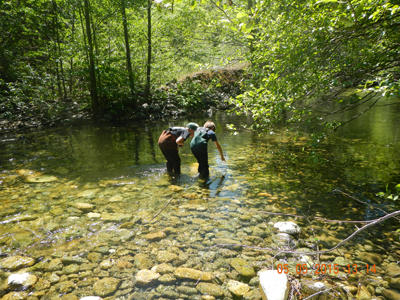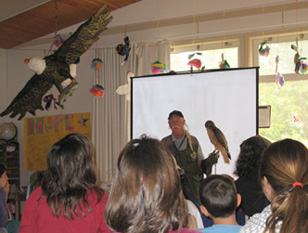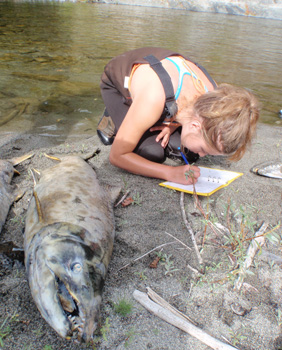Salmon River Restoration Council
- Overview
- Watershed Fair
- Student Activities
- Program Contact
Overview

Watershed Ed study of macroinvertebrates
The SRRC believes that informed, caring citizen communities are often effective stewards of the ecosystem. Our community is essential to the restoration of our watershed. To help facilitate the development our local restoration community, we run a Watershed Education Program in local schools and in the community as a whole.
Our program operates in both local schools to teach natural resource sciences, ecosystem management, and watershed stewardship. Students at Forks of Salmon Elementary School and Junction Elementary School learn scientific methods and gain valuable watershed knowledge through experiential teaching.
Our curriculum meets state standards and reflects current resource management methods. The core program includes hands-on experience with fish surveys, salmonid aquarium incubation, water monitoring, native and invasive plant management, and general education about fire, roads, wildlife, and water use. The project is enriched by volunteers from the community, local tribes and resource agencies.
The SRRC helps facilitate an annual Watershed Fair in which the students, teachers, and local organizations present their restoration work.
In addition to our program in the schools, we also hold outreach and education activities for the local community, visitors, and the general public.
Watershed Fair

Visiting Redtail Hawk and the eagle the kids made
A highlight of the Watershed Education Program is our annual Salmon River Watershed Fair, which is held in the late spring.
Community members, parents, and all of the river students come together to celebrate the uniqueness of our watershed. The event is fun and educational and gives students the opportunity to display their watershed education projects.
What Happens At the Fair?
Oral Presentations
Oral communication about learned knowledge is an important component to any education program. Students give short presentations about studies they participated in or topics they researched.
We also have speakers from wildlife agencies, the public, the Tribes or other interesting places come to show and share their knowledge of the watershed.
Poster Board Displays
Students create poster boards or visual media to display information about watershed projects they study. Professionals are also invited to display poster boards to inform students and community members about projects and studies occurring in the watershed.
Educational Activities
Students participate in fun, educational activities such as: poster board scavenger hunts, the Nose Knows game, Hooks and Ladders, making fish print t-shirts, creating watershed banners and silk paintings, and building watershed models to scale.
Student Activities

Students take data for the Fall carcass count
These are some (but not all) of the activities that are part of our watershed education curriculum.
Fall Chinook Survey
The Fall Chinook Survey is a cooperative project which produces data to help estimate of the fall Chinook population of the Salmon River.
Elementary students in grades 6-8 begin by participating in a mandatory survey training and whitewater safety course with the CA Dept. of Fish & Wildlife, USFS, the Karuk Tribe, the SRRC, and community members. After completing the training, students and teachers survey assigned stream reaches weekly looking for salmon carcasses and redds.
Students learn to take scale samples, measure carcass length, identify species and sex, tag carcasses and record their observations in data notebooks.
The data that students collect is given to the CDFW and is used to estimate salmon populations for the Salmon River. The data, together with data from the Klamath River, is then used in determining annual fishing allotments for commercial fishermen, Native American tribes, and sport fishermen.
The salmon surveys are an enriching, fun experience for children. Students learn valuable skills such as scientific techniques and protocol. The students participating in this program are set up to become excellent candidates for competitive local jobs in the natural resources field. Professionals from the USFS, the Karuk Tribe, and the CDFW have given our students high praise for their commitment to the project and the high quality of their work.
Native & Non-Native Plant Studies
River students study native and non-native plant communities by participating in botany walks, propagating native plants, and by controlling noxious weed populations.
Each year students participate in wildflower walks with local botanists and learn to identify native plants. Students have also raised native plants from seed and planted them in riparian areas along the Salmon River.
Since 1998, students have adopted sites with noxious weed problems and have eradicated weed populations using the same non-chemical techniques used in the SRRC’s Noxious Weed Program.
Water Quality Monitoring
Students in the Watershed Education Program help collect data for SRRC’s Water Quality Monitoring Program.
Students use the same protocol and data sheets as the agencies and SRRC personnel who participate in the program. In addition to monitoring temperature, students also conduct macro-invertebrate surveys, measure dissolved oxygen content, collect canopy cover information, measure channel width, and record water depth on their water quality field trips. Photo points and GPS coordinates are used to ensure consistent and accurate location of monitoring sites.
Program Contact
Shannon Flarity
Watershed Ed
Program Assistant
Salmon River Restoration Council
PO Box 1089
25631 Sawyers Bar Road (shipping only)
Sawyers Bar, CA 96027
phone: 530-462-4665
fax: 530-462-4664


Salmon River Restoration Council
PO Box 1089 | Sawyers Bar, CA | 96027
Salmon River (California)
530-462-4665
![]()